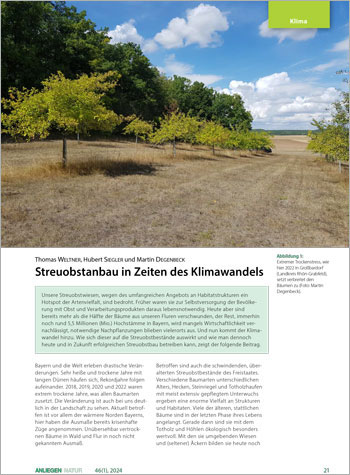Streuobstanbau in Zeiten des Klimawandels

Extremer Trockenstress, wie hier 2022 in Großbardorf (Landkreis Rhön-Grabfeld), setzt verbreitet den Bäumen zu (Foto: Martin Degenbeck).
Thomas Weltner, Hubert Siegler und Martin Degenbeck
Streuobstanbau in Zeiten des Klimawandels
Unsere Streuobstwiesen, wegen des umfangreichen Angebots an Habitatstrukturen ein Hotspot der Artenvielfalt, sind bedroht. Früher waren sie zur Selbstversorgung der Bevölkerung mit Obst und Verarbeitungsprodukten daraus lebensnotwendig. Heute aber sind bereits mehr als die Hälfte der Bäume aus unseren Fluren verschwunden, der Rest, immerhin noch rund 5,5 Millionen (Mio.) Hochstämme in Bayern, wird mangels Wirtschaftlichkeit vernachlässigt, notwendige Nachpflanzungen blieben vielerorts aus. Und nun kommt der Klimawandel hinzu. Wie sich dieser auf die Streuobstbestände auswirkt und wie man dennoch heute und in Zukunft erfolgreichen Streuobstbau betreiben kann, zeigt der folgende Beitrag.
Orchard cultivation in times of climate change
Our traditional orchards, mostly a combination of tall trunk trees and pasture, are a hotspot of biodiversity due to the extensive range of habitat structures. In the past their harvest, fresh fruits and various fruit made products, were vital for the self-sufficiency of the population.
Today these orchards are threatened. More than half of the trees have already disappeared from our fields in Bavaria, the remaining approximately 5.5 million are neglected due to a lack of economic viability and necessary replanting left undone in many places. And now climate change is added to the mix. The following article shows how orchards are affected and how successful extensive cultivation can still be practiced today and in the future.
Zum Volltext-Download:
ANLiegen Natur 46/1 (2024): 10 Seiten als Volltext herunterladen (pdf barrierefrei 1,2 MB).
 | 0
| 0 
